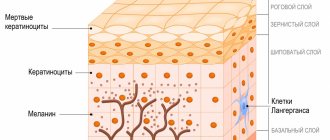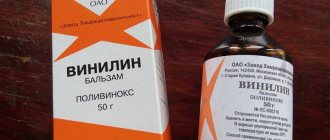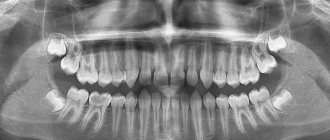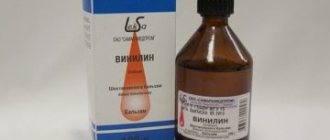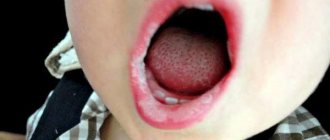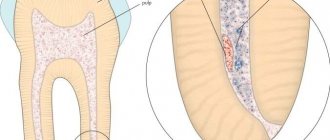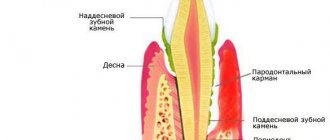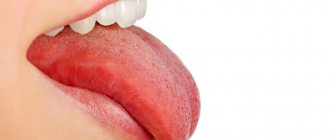Properties and release form
Vinyl is a viscous, thick liquid with a peculiar aroma. The balm has a light yellow tint. It is insoluble in water, but is miscible with chloroform, ether, liquid paraffin, ethyl alcohol and oil. Vinyl will not dry out or thicken when exposed to air.
The product is available in dark bottles of 50 g and 100 g. They are packaged in cardboard boxes and supplied with instructions. The drug is available in the form of gelatin capsules.
Description
Vinilin is used as an antiseptic for sore throats. The balm has a thick and viscous consistency. The medicine is light yellow in color and has a specific odor. The balm is sold in dark glass bottles.
The specificity of the drug is that it does not dissolve in water, but it does not dissolve in oil and alcohol. “Viniline” is also called “Shostakovsky’s Balm”. It acts as a medicine, reduces inflammatory processes, kills microbes, prevents them from actively spreading, cleans abrasions, ulcers, cuts, promotes their healing, and envelops the mucous membrane.
Vinilin has a bacteriostatic effect. The balm is sold in capsules and jars of 100 milliliters. "Vinilin" is a medicine that also has an anti-inflammatory effect. Promotes tissue regeneration, epithelization, stimulates wound healing, cleanses the skin of suppuration. After using it, the stitches heal faster and the scars become less noticeable.
Composition and pharmacological action
The active ingredient of the drug is polyvinox. It determines the effect of the medication. The balm is intended for external and internal use. When used externally, it has the following effects:
- Destroys pathogenic microbes;
- Promotes local anesthesia;
- Disinfects the wound surface;
- Dries the damaged area;
- Promotes tissue restoration;
- Stimulates the growth of new cells.
When the balm is taken orally, it envelops the damaged area, which helps relieve pain and stimulate the restoration of the mucous membrane. The recovery and healing processes are accelerated.
Use in childhood
The instructions indicate that the drug should be used from 18 years of age. In practice, many pediatricians use Vinyl for children, and even use it in the treatment of infants up to one year old. In a reduced dosage, with caution, this drug gives a noticeable therapeutic effect. Self-medication is strictly forbidden. You can use Vinilin only after consulting a doctor.
Vinilin has proven itself well in the treatment of stomatitis in children. The balm covers the damaged areas of the gums, forms a protective film over it - this promotes pain relief and rapid healing. Treatment of mucosal surfaces can occur by rinsing.
https://youtu.be/7603TRXU_W0
For babies under one year old, the balm is applied to the pacifier. For older children, you can use gauze pads to precisely apply the medication to the sore spot. Treatment is carried out several times a day. Only after eating, after 1.5 hours, should you first rinse your mouth. After lubricating the gums, you should not eat or drink for 40 minutes.
Therapy can be carried out in combination with medications. No negative reactions from the interaction of Vinilin with other drugs have been registered. Relief from using the balm for stomatitis should occur within 7 days. If this does not happen, you should consult a doctor to adjust the treatment.
Vinilin is used for the throat in the treatment of sore throat. The instructions do not indicate this method; it can be considered as a recipe for traditional medicine. During the day, the sore throat should be lubricated several times with a cotton swab dipped in balm. The procedure does not replace the use of other medications. It only helps to alleviate the child’s condition and helps relieve symptoms.
If a small child has cracks in the anal area, hemorrhoids, the balm should be applied to a sterile napkin and applied to the sore spot for 30 minutes. Do the procedure 4 times a day. Continue treatment for 1 - 2 weeks depending on the severity of the disease.
Other indications for use
Vinilin is used for a variety of damage to the skin and mucous membranes:
- Pustular lesions;
- Carbuncles;
- Vein diseases;
- Burns;
- Dermatitis;
- Boils;
- Trophic ulcers;
- Mastitis (inflammation of the mammary glands in women);
- Frostbite of the skin;
- Cuts, cracks, minor damage to the skin.
The balm is suitable for oral administration undiluted and as a mixture with vegetable oil. Vinylin can be mixed with other dosage forms - ointments, pastes. The balm is used internally to treat ulcers and gastritis with high acidity.
Vinilin (Shostakovsky balm) 50ml
Dosage form:
balm
Compound
Polivinox (vinyline) – 50 g or 100 g
Description:
thick, viscous liquid of light yellow color, specific odor. Doesn't thicken or dry out in air.
Pharmacotherapeutic group:
antiseptic
ATX code:
[D08AX]
pharmachologic effect
It has an antimicrobial effect, promotes wound cleansing, tissue regeneration and epithelization. When taken orally, it acts as an enveloping, anti-inflammatory and bacteriostatic agent.
Indications for use
Externally: boils, carbuncles, trophic ulcers, purulent wounds, mastitis, soft tissue wounds, burns and frostbite.
Orally: in the complex treatment of erosive and ulcerative diseases of the stomach and duodenum, exacerbation of chronic gastritis with increased secretory function of the stomach.
Contraindications
Hypersensitivity.
When taking the drug orally: diseases of the liver, gall bladder and kidneys, pregnancy, breastfeeding, children under 18 years of age.
Directions for use and doses
Externally: for wetting wipes and direct application to the wound surface in sufficient quantities.
Orally: 1 time per day 5-6 hours after the last meal (a light dinner is recommended at 18:00 and taking the drug at 23-24:00).
For gastric and duodenal ulcers: 1 teaspoon on the first day, on subsequent days - 1 dessert spoon, course - 16-20 days.
For gastritis with increased secretory function: 1 teaspoon on the first day, then 1 dessert spoon every other day, course – 10-12 days.
Side effect
Allergic reactions.
Overdose
There are no data on cases of overdose.
Interaction with other drugs
Not studied.
Release form
Balm.
50 g, 100 g of the drug in orange glass bottles with a screw neck, sealed with polymer stoppers and polymer screw caps.
50 g, 100 g in polyethylene terephthalate bottles, sealed with polymer screw caps.
Each bottle, along with instructions for use, is placed in a cardboard pack.
It is allowed to place bottles in group packaging with an equal number of instructions for use.
Best before date
5 years. Do not use after the expiration date stated on the packaging.
Storage conditions
In a well-closed container, in a dry place, protected from light, at a temperature not exceeding 25 ° C.
Keep out of the reach of children.
Conditions for dispensing from pharmacies
Over the counter.
Contraindications
Vinilin is not prescribed for the following diseases and conditions:
- Diseases of the liver, kidneys, gall bladder;
- Pregnancy;
- Individual intolerance;
- Lactation period;
- Children's age (for oral administration).
During pregnancy and breastfeeding, it is possible to use the balm externally under the supervision of a physician.
Side effects
Vinylin is well tolerated by patients. When using the balm for children, do not exceed the dosage. Children's skin is delicate and sensitive, it can respond with an allergic reaction.
Possible side effects:
- Dryness, flaking of the skin;
- Feeling of tightness;
- Itching;
- Redness;
- Disturbance of stool when taken orally.
If negative symptoms appear, you should stop using the balm and consult your doctor.
When used together, Vinilin and antacids can enhance the therapeutic effect of each other. If the balm and antibiotics are used together, the action of the latter may be hindered. Vinilin envelops the mucous membranes of the digestive system and prevents the absorption of drugs. It is necessary to time limit the intake of these medications.
Medicines VINYLIN (for internal use)
Instructions| History of creation | What cures | Where can I buy |
The use of Vinilin in dentistry The use of mixtures with Shostakovsky balm in the treatment of certain pathological conditions of the soft tissues of the oral cavity Clinical studies were carried out at the Department of Surgical Dentistry of the I Leningrad Medical Institute. acad. I.P. Pavlova. The results of the study were published in the journal “Dentistry” No. 1, 1977. Vinilin (Shostakovsky’s balm) has pronounced anti-inflammatory and bacteriostatic properties, has a beneficial effect on reparative processes in the treatment of both fresh and trophic ulcers (B.M. Blyakhman, 1948; V.A. Avakova and Z.F. Shostakovsky, 1949; E.Y. Chass, 1950; V.A. Sondak and A.I. Ruderman, 1951; G.M. Vitalieva et al., 1967; L.N. Tikhonov and V.N. Tikhonova, 1970; I.G. Kuznetsov, 1971). Using Shostakovsky balm for 7 years, we were convinced of its healing effect in many pathological processes in the soft tissues of the oral cavity: gingivitis, stomatitis, glossitis, processes such as leukoplakia, etc. Shostakovsky's balm turned out to be very effective as a preventive and therapeutic agent during radiation therapy for oncological diseases of the maxillofacial area and already developed post-radiation lesions of the oral mucosa. We use balm mixtures containing anesthesin for glossalgia and for various manifestations in the oral cavity of intolerance or irritation of the plastic of removable dentures. The balm was applied topically while simultaneously eliminating the effects of local and general pathogenic factors. As our experience has shown, in order to prevent post-radiation lesions of the oral mucosa, it is advisable to use Shostakovsky balm in its pure form; for more pronounced phenomena, a mixture of balm with vitamin A. If in these cases a burning sensation, parasthesia or pain is noted, anesthesin is added to this mixture , and if there is bleeding gums, vitamin K is added to the mixture. In case of severe inflammatory phenomena, which often occur with periodontal disease, we add sulfonamide preparations to the mixture of balm, vitamin A and other ingredients. The dosage of each of these ingredients varies depending on the form and severity of the pathological process. Below are approximate recipes for the individual mixtures of Shostakovsky balm used.
| Mixture 1 Rp. Vinylinum 50.0 Vitamini A 6 -10.0 Oleosa Ol.Menthae Piperitae 1.0 | Mixture 4 Rp. Vinylinum 50.0 Vitamini A 6 -10.0 Oleosa Streptosidi albi 10.0 Ol.Menthae Piperitae 1.0 |
| Mixture 2 Rp. Vinylinum 50.0 Vitamini A 6 -10.0 Oleosa Anaesthesini 4-8.0 | Mixture 5 Rp. Vinylinum 50.0 Vitamini A 6 -10.0 Oleosa Vitamini K 0.5 Sulfodimetoxini 10-15.0 |
| Mixture 3 Rp. Vinylinum 50.0 Vitamini A 6 -10.0 Oleosa Vitamini K 0.5 Ol.Menthae Piperitae 2.0 | Mixture 6 Rp. Vinylinum 50.0 Vitamini A 6 -10.0 Oleosa Vitamini K 0.5 Anaesthesini 4-8.0 Sulfodimetoxini 10-15 Ol.Menthae Piperitae 2.0 |
In order to eliminate the unpleasant taste, especially for patients with hypersensitivity, peppermint infusion or oil is added to the balm mixture. Before use, the balm is heated in a water bath and the ingredients specified for the intended purpose are added, if necessary. The patient directly from the bottle takes 1-1.5 ml of the drug into his mouth and actively lubricates the entire mucous membrane with his tongue, while making movements for 5-8 minutes, as when rinsing the mouth. The balm is mixed with saliva, and then the patient swallows it. By the way, patients suffering from stomach disease usually note an improvement in their condition after using the indicated doses of balm. For limited lesions of the oral mucosa and the development of pathological foci in the area of the lower lip, lubrication or application with the indicated balm mixtures is used. For periodontal disease with severe inflammatory changes and bleeding, gum massage is indicated. Without heating, mix the balm thoroughly, then take a piece of lemon peel or foam sponge measuring 4x5 cm and apply a layer of one of the indicated mixtures (usually No. 5 or No. 6) to its inner surface and massage with the index finger of the right hand for 5-8 minutes gums on both sides. The balm or its mixture is used 1-2 times a day, 2 hours before meals or after meals and at night. According to the described method, Shostakovsky balm in its pure form was used in 36 patients to prevent complications of radiation therapy. Only 4 patients had a minor post-radiation reaction; in the remaining patients, the development of any complications from the oral mucosa was completely prevented. Shostakovsky's balm and, in particular, its mixture No. 2 are very effective for such sensitivity disorders as glossalgia and various manifestations of paresthesia (burning sensation, etc.) that have developed from various causes. In 42 patients with the specified suffering, the use of a mixture of balm No. 2 was successful. Already by the 5-6th day of treatment, patients noted an improvement, and after a 15-20-day course of treatment, in most patients the complaints completely disappeared. And only in some patients complete success was achieved after a second course of therapy, which was administered 8-10 days after the first. Finally, in 62 patients with various inflammatory manifestations of periodontal disease, mixtures No. 4, 5 and 6 were used. The choice of one or another mixture depended not only on the nature and intensity of the inflammatory reaction, but also on the degree of sensitivity disorders and bleeding gums. In these patients, good results can be achieved through a 12-20-day course of treatment. The inflammatory reaction noticeably decreased, hypersensitivity symptoms partially or completely disappeared, and gum bleeding stopped. If an exacerbation of the process occurred, repeated courses of treatment were carried out after a 10-12-day break. Experience has shown that even long-term use with appropriate short breaks of mixtures of Shostakovsky balm, including those containing sulfonamide drugs, does not cause any local or general complications. In only 8 patients, the researchers were forced to refuse treatment with the balm due to intolerance to its smell and taste. Thus, the absence of any harmful effects even with long-term use of the balm and medicinal substances included in mixtures based on it, with such a high therapeutic effectiveness, makes it possible to widely recommend the use of Shostakovsky balm and mixtures based on it in the practice of a dental clinic. Complex treatment of periodontal disease using biomycin paste on Shostakovsky balm The study was carried out in the Sochi sanatorium of the USSR Ministry of Defense (Sochi). The results of the study were published in the journal “Dentistry” No. 1 for 1967. This work evaluates the complex treatment of periodontal disease using biomycin paste based on Shostakovsky balsam. Under observation were 120 patients with periodontal disease (88 men and 32 women). There were 4 patients under the age of 30 years, 34 patients from 31 to 40 years old, 33 patients from 41 to 50 years old. Of the observed patients with periodontal disease: 62 - functional disorders of the nervous system; 47 — cardiovascular diseases; 4 - metabolic diseases; 3 - diabetes mellitus; 2 — disease of the gastrointestinal tract; 2 - there are no diseases of internal organs. The sclerotic form of periodontal disease was observed in 47 patients, mixed - in 60 and abscessive - in 13. Of these, 12 people had degree I damage, 85 - II, and 23 - III. Local treatment consisted of removing supragingival and subgingival tartar, curettage of pathological gingival pockets, followed by treating them with biomycin paste (50,000 units of biomycin were mixed in 1 ml of Shostakovsky balm). The paste was prepared before use and used daily or every other day. In addition, the oral cavity was irrigated with Matsesta water for 5-10 minutes. (hydrogen sulfide concentration 150 ml, temperature 37-38? C), gum electrophoresis was performed with a 5% ascorbic acid solution, 10% calcium chloride solution, aloe therapy, abscesses were opened. The immediate results of complex treatment of periodontal disease using biomycin paste on Shostakovsky balsam showed that 88 patients experienced significant improvement in the first days. Analyzing the results of complex treatment of periodontal disease, the following conclusion was made: in patients with sclerotic forms of periodontal disease I-III degrees, good results are achieved by irrigating the oral cavity with Matsesta water in combination with physiotherapeutic procedures and treating pathological gum pockets with biomycin paste. For mixed and abscessive forms of periodontal disease II-III, in addition to oral irrigation and physiotherapeutic treatment, it is advisable to carry out aloe injections, and it is also necessary to treat pathological gum pockets with biomycin paste. It very quickly eliminates inflammation, reduces pain and stops discharge from pathological gum pockets. The paste has not only antimicrobial and anti-inflammatory, but also an anesthetic effect, promoting a sustainable cure for hyperesthesia of exposed tooth necks.
